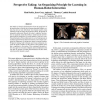Free Online Productivity Tools
i2Speak
i2Symbol
i2OCR
iTex2Img
iWeb2Print
iWeb2Shot
i2Type
iPdf2Split
iPdf2Merge
i2Bopomofo
i2Arabic
i2Style
i2Image
i2PDF
iLatex2Rtf
Sci2ools
AAAI
2006
2006
Perspective Taking: An Organizing Principle for Learning in Human-Robot Interaction
The ability to interpret demonstrations from the perspective of the teacher plays a critical role in human learning. Robotic systems that aim to learn effectively from human teachers must similarly be able to engage in perspective taking. We present an integrated architecture wherein the robot's cognitive functionality is organized around the ability to understand the environment from the perspective of a social partner as well as its own. The performance of this architecture on a set of learning tasks is evaluated against human data derived from a novel study examining the importance of perspective taking in human learning. Perspective taking, both in humans and in our architecture, focuses the agent's attention on the subset of the problem space that is important to the teacher. This constrained attention allows the agent to overcome ambiguity and incompleteness that can often be present in human demonstrations and thus learn what the teacher intends to teach.
| Added | 30 Oct 2010 |
| Updated | 30 Oct 2010 |
| Type | Conference |
| Year | 2006 |
| Where | AAAI |
| Authors | Matt Berlin, Jesse Gray, Andrea Lockerd Thomaz, Cynthia Breazeal |
Comments (0)

